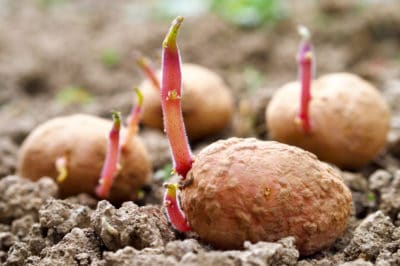Growing Potatoes
Potatoes can be grown in all climates and USDA zones, although you may need to adjust planting times to prevent frost damage or excessively warm growing temperatures. Not fussy about soil, they need plenty of water while actively growing. You can plant early, mid-season and late varieties at the same time to have potatoes at all times of the year.
About the Sprout
The potato sprout is simply the earliest stage of a potato’s stems. Sprouts grow from indentations known as eyes. Potato tubers – which are not roots – develop along the length of the sprouts, which must be buried under soil, or hilled, as the plants grow. There are things you can do to inhibit sprouting in stored potatoes. Sprouting potatoes can be used to hasten ripening in other fruits and vegetables.
Storing Potatoes
Storing potatoes correctly is one of the best ways to prevent early sprouting. First, store them in the darkest area you can find. Although you should periodically check your potatoes and remove any that have sprouted or are rotting, minimize light exposure. Second, keep the temperature between 40°F and 50°F (4 and 10°C). Keep the humidity between 90 and 95 percent.
Can You Eat Sprouts?
Potatoes belong to the Solanaceae family, the same group in which you will find tomatoes, eggplants and deadly nightshade. All of these produce a chemical known as solanine. Solanine is toxic even in quite small amounts. Potato sprouts and stems contain considerable solanine, which can cause headache, breathing difficulties and gastrointestinal distress. Potato skin or flesh that is green also contains solanine.
Potato Sprout Color
Potato sprouts are typically white or cream with a pink tinge. If exposed to sun, they will develop green leaves. Some potatoes, however, naturally produce colored sprouts. These heirlooms include:
- Kestrel – pink and purple
- Shetland Black – deep purple-black
- Sharpes’ Express – pale pink
- Highland Burgundy Red – reddish-purple
- Salad Blue – deep blue-black.
Planting Sprouted Potatoes
Potatoes that have sprouted can be planted and grown in the garden or containers. It’s best to use potatoes with sprouts less than one inch in length. Place them in the sun for a few days to develop green leaves if desired or just plant as is. The tip of the sprout should be above ground. Plant in a trench about six inches deep as you will need to hill dirt over them as they grow.
Eating Sprouted Potatoes
Whether to eat sprouted potatoes is often a matter of controversy. However, it’s really dependent on the degree of sprouting. When potatoes first begin to sprout, they produce small nubbins that can easily be cut off with a knife or dug out with a vegetable peeler. These are definitely edible. As the sprouts grow larger, they begin to break down the potato flesh. Spouted potatoes that are soft or rotting should not be eaten.
Sprout Inhibitors
Commercial growers spray potatoes with sprout inhibitors or use radiation to prolong storage. For the organic gardener, these methods may not be an option. Researchers have been experimenting with essential oils. Clove oil, spearmint oil, peppermint oil and mint oils in general, as well as a compound in caraway seeds called carvone, may inhibit sprouting. The potatoes are sprayed with the dilute essential oils after being cured.
Promoting Ripening with Sprouted Potatoes
Potatoes that are sprouting give off ethylene gas. Apples and bananas do the same thing, which is why these fruits shouldn’t be stored together. While this is a problem if you have different fruits and vegetables in a fruit cellar, it can also be a way to hasten ripening. You can place tomatoes, peppers and fruits such as peaches in a paper bag with a sprouted potato to hasten ripening.
Using Sprouted Potatoes
Once your potatoes start to sprout, all the potatoes in that bag or box tend to follow suit, leaving you to wonder how to preserve them. Raw potatoes don’t freeze at all, but some cooked potato dishes can be frozen. You can make twice-baked stuff potatoes; stuff the shells and then freeze. Make freezer hash browns or freezer french fries. Cook, grate or slice, and freeze in a half-inch thick layer for hash browns or a single layer for french fries. Cook in hot oil without defrosting.
